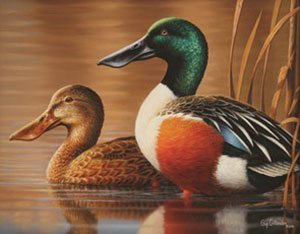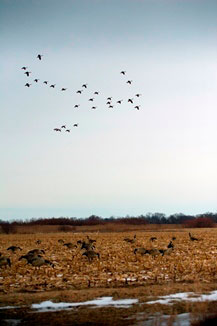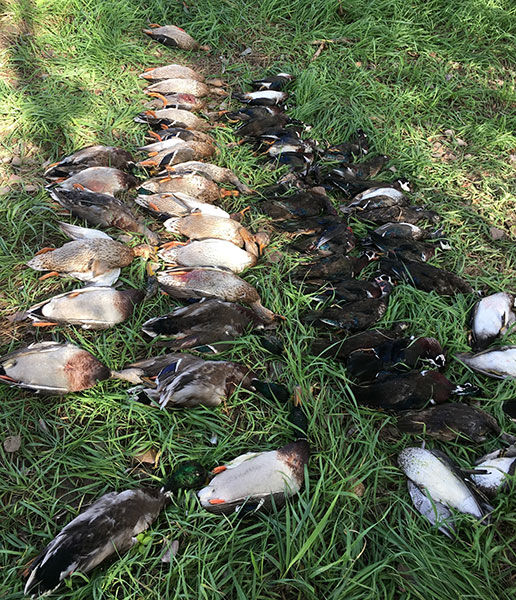- Details
(Provided by MDNR)
 New Michigan Duck Stamp Features Two ShovelersThe Michigan Duck Hunters Association, in cooperation with the Michigan DNR, has introduced the 2017 collector's edition Michigan duck stamp and prints.
New Michigan Duck Stamp Features Two ShovelersThe Michigan Duck Hunters Association, in cooperation with the Michigan DNR, has introduced the 2017 collector's edition Michigan duck stamp and prints.
The Michigan Waterfowl Stamp Program, established in 1976, has become an icon for waterfowl hunters and wetland conservation enthusiasts. During the past 41 years, the program has gained popularity with collectors and conservation groups throughout the United States.
The Michigan Duck Hunters Association, a nonprofit organization dedicated to waterfowl and wetland conservation, coordinates the program in partnership with the DNR. Proceeds from stamp sales will be used to fund Michigan Duck Hunters Association projects, with 10 percent used to match DNR funding for purchasing, restoring and enhancing wetlands.
- Details
(Provided by MDNR)
Earlier this year, the Michigan DNR staff took to the sky in small aircraft to observe and count ducks, geese and swans on southern Michigan waterways.
DNR Wildlife Division staff observed 148,521 ducks, 49,840 geese and 5,103 swans in 2017s survey.
In the 2016 survey, 157,028 ducks, 33,468 geese and 5,896 swans were observed. Goose observations increased in 2017, while duck observations were down about 5 percent and swan observations down 13 percent.
- Details
By Louie Stout
Michiana waterfowl hunters still have time to harvest geese in Michigan this season.
The DNR encourages hunters to pursue this delicious, locally sourced game and to pass the tradition of goose hunting on to a new generation of hunters.
Indiana's North Zone remains open through Feb. 12. Michigan's South Zone late Canada goose season continues through Feb. 11, with a couple of exceptions.
The Muskegon County Wastewater System Goose Management Unit is not open for late season goose hunting.† The Allegan County Goose Management Unit is open for late-season goose hunting through Feb. 12. The Fennville Farm Unit at Allegan State Game Area holds drawings for goose hunting zones on Monday, Wednesday, Friday, Saturday and Sunday mornings and Tuesday and Thursday afternoons.
- Details
By Louie Stout
 Goose Hunting Opportunities Continue for Michiana HuntersMichiana waterfowl hunters still have time to harvest geese in Michigan this season.
Goose Hunting Opportunities Continue for Michiana HuntersMichiana waterfowl hunters still have time to harvest geese in Michigan this season.
The DNR encourages hunters to pursue this delicious, locally sourced game and to pass the tradition of goose hunting on to a new generation of hunters.
Indiana’s North Zone remains open through Feb. 12. Michigan’s South Zone late Canada goose season continues through Feb. 11, with a couple of exceptions.
The Muskegon County Wastewater System Goose Management Unit is not open for late season goose hunting. The Allegan County Goose Management Unit is open for late-season goose hunting through Feb. 12. The Fennville Farm Unit at Allegan State Game Area holds drawings for goose hunting zones on Monday, Wednesday, Friday, Saturday and Sunday mornings and Tuesday and Thursday afternoons.
- Details
(Provided by MDNR)
 Poachers who killed nearly 60 ducks received stiff sentences.
Poachers who killed nearly 60 ducks received stiff sentences.
Poachers who killed nearly 60 ducks received stiff sentences.
Four Ottawa County men ticketed recently for poaching nearly 60 wild ducks from a private agricultural pond near the Grand River watershed were sentenced this week in district court.
Tyler John Meerman, 24, of Conklin, Colson Thomas Modderman, 22, of Wyoming, Justin Allen Beckman, 20, of Coopersville; and Michael Duane Sorenson III, 20, of Marne pleaded guilty Tuesday and were sentenced the same day in Ottawa County District Court.
The convictions resulted from an Oct. 9 incident, near a popular waterfowl hunting area in Chester Township, which is situated in the northern part of the county. A total of 58 ducks were killed.
"These four individuals used over 200 pounds of corn to illegally entice these ducks in for the kill," said DNR conservation officer Dave Rodgers. "The men were not using decoys or duck calls and therefore were not hunting, but rather, they were poaching."
The use of bait for duck hunting is not allowed. The ducks poached included 35 wood ducks and 23 mallards, including 13 mallard hens.




